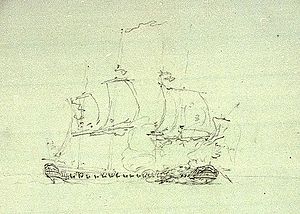HMS Nymphe (1780)

A sketch of the engagement between Nymphe and Cleopatre by Nicholas Pocock, 1793
|
|
| History | |
|---|---|
|
|
|
| Name: | La Nymphe |
| Namesake: | Nymph |
| Builder: | Pierre-Augustin Lamothe, Brest |
| Laid down: | April 1777 |
| Launched: | 18 August 1777 |
| Commissioned: | November 1777 |
| Fate: | Captured by HMS Flora, 10 August 1780 |
|
|
|
| Name: | HMS Nymphe |
| Acquired: | by capture, 10 August 1780 |
| Honours and awards: |
|
| Fate: | Wrecked in the Firth of Forth, 18 December 1810 |
| General characteristics | |
| Type: | Fifth-rate frigate |
| Tons burthen: | 937 72⁄94 (bm) |
| Length: |
|
| Beam: | 38 ft 3 1⁄4 in (11.66 m) |
| Depth of hold: | 11 ft 9 in (3.58 m) |
| Sail plan: | Full-rigged ship |
| Complement: | 240 |
| Armament: | |
| Service record | |
| Operations: |
|
HMS Nymphe was a fifth-rate frigate of the British Royal Navy, formerly the French La Nymphe. She was captured by HMS Flora, under the command of Captain William Peere Williams, off Ushant on 10 August 1780. Indiscriminately referred to as Nymph, Nymphe, La Nymph or La Nymphe in contemporary sources, she served during the American, French Revolutionary and Napoleonic Wars. On 19 May 1793, while under the command of Captain Edward Pellew, she captured the frigate Cléopâtre, the first French warship captured in a single-ship action of the war. After a long period of service in which she took part in several notable actions and made many captures, Nymphe was wrecked off the coast of Scotland on 18 December 1810.
La Nymphe was built as a 32-gun frigate of the fourth rate (Quatrième Rang) at Brest, designed and constructed by Pierre-Augustin Lamothe. She was laid down in April 1777, launched on 18 August, and commissioned in November. She carried a complement of 290 men, and was armed with twenty-six French 12-pounder guns and six French 6-pounders.
The 36-gun frigate Flora was patrolling off Brest on the afternoon of 10 August 1780 when through the haze she sighted two vessels, a square-rigged vessel and a cutter, about four miles away. As Flora approached, the cutter edged away, while the square-rigged vessel waited, accepting battle. When the two ships were within two cables length the French ship raised her colours and opened fire. The battle lasted about an hour, until Flora, being much cut up, moved closer in. After another 15 minutes the French abandoned their guns and attempted to board, but were repulsed and the crew of Flora boarded her and took possession. She proved to be the frigate La Nymphe, pierced for 40 guns, but mounting only 32, and commanded by the Chevalier Charles-Marie de Trolong du Rumain, who died that evening of his wounds.Flora, as well as her nominal armament of 36 guns, also carried six recently-introduced 18-pounder carronades, which swept the decks of the French ship with grapeshot. In addition Flora's guns were heavier, 18- and 9-pounders, against the French ship's 12- and 6-pounders. This is reflected in the number of casualties; 9 killed and 17 wounded on Flora out of a crew of 259, and 55 killed and 81 wounded aboard La Nymphe, from a crew of 291.
...
Wikipedia
